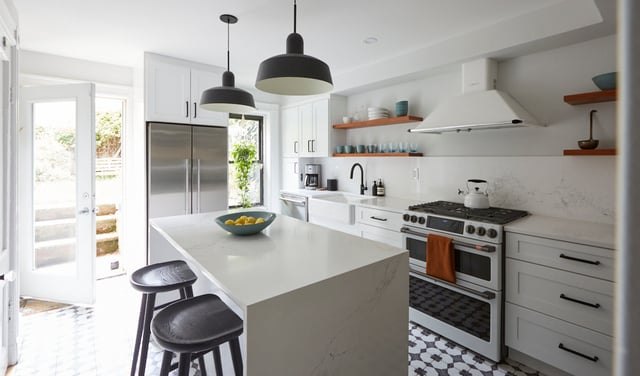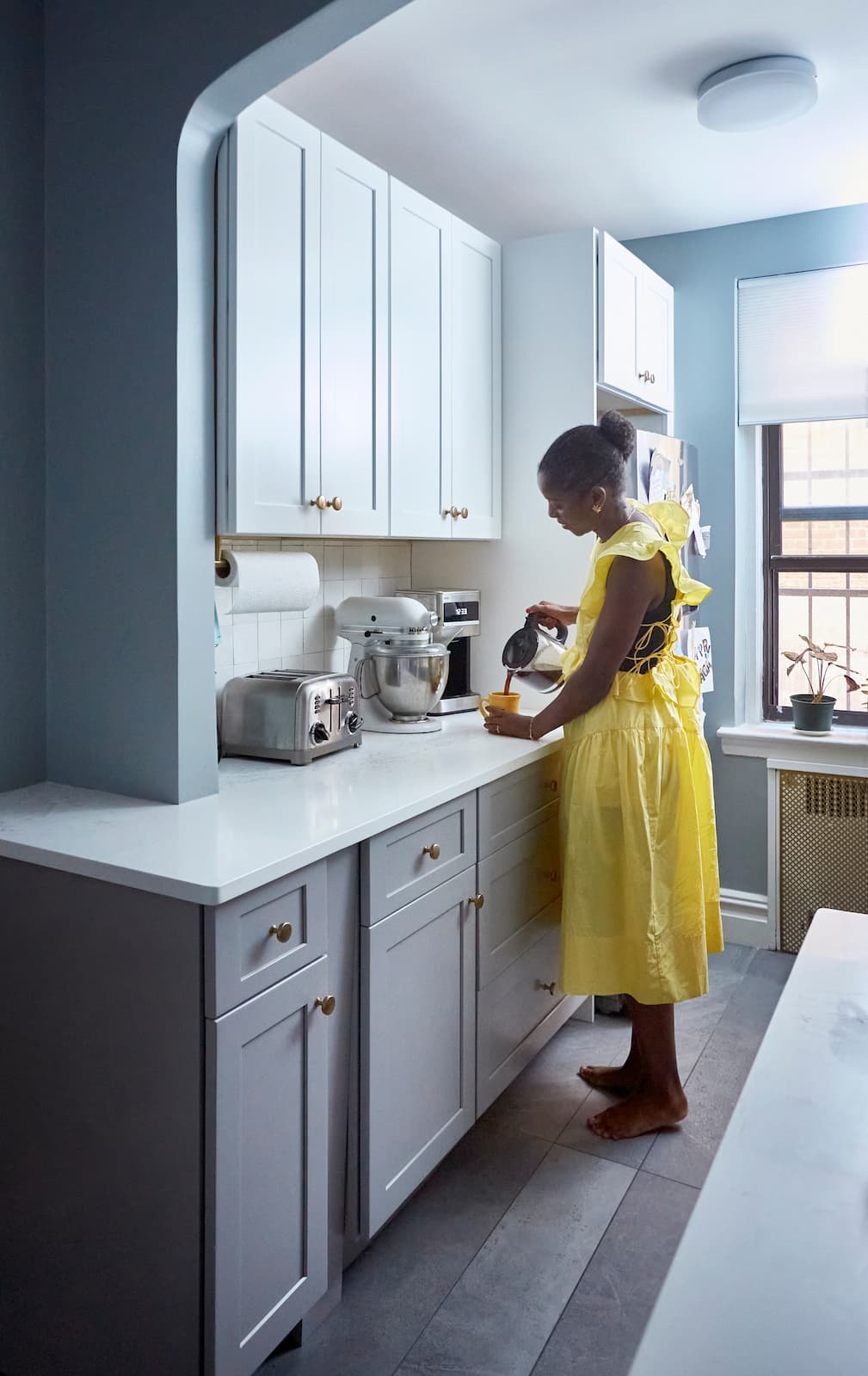What’s Better? Kitchen Peninsulas or Islands

In This Article
When it comes to designing a kitchen, the layout plays a crucial role in functionality, aesthetics, and flow. Two of the most popular features in modern kitchens are peninsulas and islands, each offering distinct benefits and potential drawbacks. Choosing between them can be challenging, as the right option largely depends on your kitchen’s size, design, and your personal needs. In this comprehensive guide, we explore the differences, benefits, and considerations of kitchen peninsulas versus islands to help you determine which option is best for your space.
Learn More: Understanding Kitchen Renovation Timelines and Phases
What is a Kitchen Peninsula?
A kitchen peninsula is a countertop extension that is connected to the main kitchen, creating a three-sided work area with one end attached to a wall or cabinetry. It often acts as a divider between the kitchen and an adjacent room, such as a dining area or living space. Peninsulas are a hallmark of L-shaped or U-shaped kitchens and are popular for smaller spaces where a freestanding island may not be practical.
What is a Kitchen Island?
A kitchen island is a freestanding unit that can be accessed from all sides, providing additional countertop space, storage, and sometimes seating. Islands are often positioned in the center of the kitchen and can be customized with sinks, stovetops, or built-in appliances. They are common in open-concept kitchens, offering a central hub for cooking, dining, and socializing.
Pros and Cons of Kitchen Peninsulas
Pros:
-
Space Efficiency:
-
Peninsulas maximize countertop space without requiring additional floor area, making them ideal for small or narrow kitchens.
-
-
Cost-Effective:
-
Since a peninsula is attached to existing cabinetry or walls, it generally costs less to install compared to a freestanding island.
-
-
Increased Storage:
-
Like islands, peninsulas provide ample storage options, with cabinets and drawers often built underneath the countertop.
-
-
Defined Space:
-
Peninsulas help define the kitchen’s boundaries, creating a sense of separation between the kitchen and adjacent rooms without the need for walls.
-
Cons
-
Limited Accessibility:
-
Unlike islands, peninsulas can only be accessed from three sides, which may limit workflow and seating options.
-
-
Potential Traffic Bottlenecks:
-
In smaller kitchens, the fixed nature of a peninsula can create congestion, particularly when multiple people are cooking or moving around.
-
-
Less Open Layout:
-
While peninsulas create a natural divider, they can also make the kitchen feel more enclosed, especially in smaller spaces.
-
Learn More: Best Colors to Paint Your Kitchen Walls
Pros and Cons of Kitchen Islands
Pros
-
Multi-Sided Access:
-
Islands are accessible from all sides, making them ideal for multiple users and tasks, such as food prep, dining, and socializing.
-
-
Customizable Features:
-
Islands offer endless customization options, including built-in appliances, sinks, seating areas, and additional storage.
-
-
Open and Social Layout:
-
Positioned at the center of the kitchen, islands encourage interaction and are perfect for open-concept living spaces.
-
-
Ample Workspace:
-
With larger surface areas, islands provide plenty of space for meal preparation, baking, and serving.
-
Cons
-
Requires Adequate Space:
-
Islands typically need a larger kitchen layout to avoid crowding or disrupting the flow of movement.
-
-
Higher Cost:
-
Due to their freestanding nature and customization options, islands can be more expensive to install than peninsulas.
-
-
Potential for Clutter:
-
Without proper organization, the large surface area of an island can easily become a catch-all for clutter.
-
-
Traffic Flow Disruptions:
-
If placed inappropriately, islands can create obstacles that hinder movement within the kitchen.
-
Key Factors to Consider When Choosing Between a Peninsula and an Island
1. Kitchen Size and Layout
-
Small Kitchens: Peninsulas are generally better suited for compact kitchens where floor space is limited. They maximize functionality without compromising movement.
-
Large Kitchens: Islands work well in spacious kitchens, providing a central gathering point and additional workspace.
2. Functionality Needs
-
Meal Prep and Cooking: If you require ample space for meal preparation and cooking, an island offers more versatility, especially if it includes features like a sink or cooktop.
-
Casual Dining: Both peninsulas and islands can accommodate seating, but islands typically offer more flexible options for larger families or gatherings.
3. Budget Constraints
-
Cost of Installation: Peninsulas are often more budget-friendly due to their simpler installation process. Islands, with their freestanding design and customization options, tend to be more expensive.
-
Customization Costs: Consider the additional expenses of built-in appliances, storage, and electrical wiring, which are more common in island installations.
4. Traffic Flow and Accessibility
-
Ease of Movement: Islands allow for free-flowing movement around the kitchen, making them ideal for larger households or multiple cooks.
-
Defined Spaces: Peninsulas can act as natural dividers, creating distinct zones within an open-concept space.
5. Aesthetic Preferences
-
Open and Airy Feel: Islands contribute to a more open and spacious feel, especially in open-concept kitchens.
-
Defined Boundaries: Peninsulas provide a cozier, more defined space, which may suit traditional or smaller kitchens.
Design Trends: Modern Peninsulas and Islands
Both peninsulas and islands have evolved to fit modern kitchen designs. Here are some popular trends to consider:
-
Multi-Level Countertops: Both options can include multi-level countertops for separate prep and dining areas.
-
Waterfall Countertops: For a sleek, modern look, consider waterfall countertops that extend down the sides.
-
Built-In Storage Solutions: Islands and peninsulas with pull-out shelves, wine racks, or hidden cabinets maximize functionality and organization.
-
Statement Lighting: Pendant lighting above the island or peninsula adds both task lighting and a decorative touch.
-
Mixed Materials: Combining materials like wood and quartz or granite can add texture and depth to your kitchen design.
When to Choose a Kitchen Peninsula
A kitchen peninsula is a smart choice if:
-
Your kitchen is small or medium-sized, and you want to maximize space.
-
You prefer a more cost-effective option.
-
You want a defined boundary between the kitchen and adjoining spaces.
-
Your kitchen layout already includes an L-shape or U-shape design.
When to Choose a Kitchen Island
A kitchen island is ideal if:
-
You have a large, open kitchen with plenty of floor space.
-
You want a multi-functional space for cooking, dining, and socializing.
-
You’re interested in adding custom features like a sink, stove, or wine fridge.
-
You prefer a more open and airy kitchen layout.
Combining Both: Hybrid Solutions
In some cases, combining both an island and a peninsula can provide the best of both worlds, particularly in large kitchens. Hybrid designs often feature a central island for food prep and socializing, along with a peninsula that creates additional seating or a transition into the dining or living area. This approach maximizes storage, functionality, and visual appeal while maintaining efficient workflow.
Final Verdict: Which is Better?
There is no one-size-fits-all answer when it comes to choosing between a kitchen peninsula and an island. The best option depends on your kitchen’s size, layout, budget, and personal preferences. Peninsulas excel in smaller kitchens by providing ample storage and workspace without consuming too much floor area. Meanwhile, islands shine in open, spacious kitchens where they can serve as a central hub for cooking, dining, and entertaining.
For homeowners who prioritize budget and space-saving solutions, a peninsula is likely the better fit. Conversely, if you have the space and desire for a customizable, multi-functional feature, a kitchen island may be the way to go.
Ultimately, both options can transform your kitchen into a more functional and inviting space—it all comes down to selecting the one that aligns with your needs and design goals.

Renovate confidently with Block
Easily compare quotes from top quality contractors, and get peace of mind with warranty & price protections.
Thousands of homeowners have renovated with Block

4.5 Stars (100+)

4.7 Stars (100+)

4.5 Stars (75+)
Renovate confidently
- Top quality contractors
- Warranty & price protections
- Expert resources





